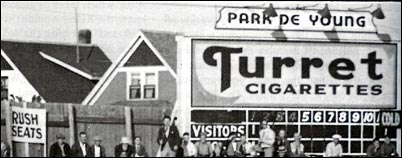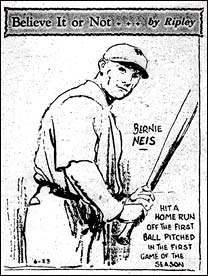A New Beginning
As the spring of 1931 unfolded, a full decade had passed since the dissolution of the professional W.C.B.L. on the prairies. Yet, amateur baseball in southern Saskatchewan had continued unfettered during that ten year span as tournament prize money during the "roaring twenties" had enticed teams to lure "hired guns" from south of the border. One of the most notable was John Donaldson, a black southpaw pitcher who was the most dominant hurler outside of the major leagues during this era.
Also appearing regularly on southern Saskatchewan diamonds were a pair of former Chicago White Sox' teammates, Oscar "Happy" Felsch and Charles "Swede" Risberg, both of whom had been banished from "organized baseball" by Commissioner Kenesaw Mountain Landis. The federal judge had been hired by major league club owners to restore confidence in the sport following the 1919 "Black Sox" scandal.
The 1929 stock market crash had ushered in the Great Depression and unemployment was now rampant. Saskatchewan's agrarian economy was hit especially hard as crop prices fell by approximately 60%. In spite of the close proximity between Regina and Moose Jaw, inter-city baseball games between the two south Saskatchewan hubs had virtually vanished for most of the preceding seasons. Although amateur clubs played each other occassionally in tournament action on neutral ground, neither a professional nor amateur circuit had been in place to keep the long-standing rivalry between the two adversaries at the previous intensity. As a new generation of ball players emerged, memories of the battles between the Robin Hoods/Millers and the Bonepilers/Red Sox/Senators began to fade, especially in view of the dire economic circumstances that the province and nation faced.

Park de Young was home field for Regina's clubs in the early days of the Southern League
Amid little fanfare, a group of south Saskatchewan baseball enthusiasts from three communities met on May 15, 1931 in Regina and set the wheels in motion for the formation of the Southern Saskatchewan Baseball League (commonly referred to as simply the Southern League), a circuit which would endure until 1974, a span of some 44 seasons although 1943 saw the league operate as more of a Regina and district association with the war effort in full swing. The Southern League's longevity ranks second to none as the longest running baseball league in Saskatchewan's history.
Five teams were charter members of the new league. Representing Regina were the Balmorals, the Rifles and the Shamrocks. Moose Jaw's entry, a select squad from the Mill City's three city league teams, was known as the All-Stars (by the Regina media) or the Cats (on home turf). The fifth entry, from the small community of Milestone, was called the Sioux. W. R. Stewart of Regina was named the president of the new league. A forty-game schedule was drawn up with each team expected to play sixteen games. The top three finishers would then enter the playoffs with the first place team receiving a bye.
The summer months of 1931 in southern Saskatchewan were strange indeed from a weather standpoint. A sustained drought took hold and more Southern League games were delayed or postponed by dust storms than by precipitation. The Moose Jaw entry started the season slowly but finished strong to take the regular season pennant and then followed up their initial success by downing the Regina Balmorals in the playoff final
Moose Jaw, champions of the Southern League, downed the Northern Saskatchewan champion Saskatoon St. Joseph's to win the Leader-Post trophy, emblematic of the provincial senior baseball championship,
In Edmonton, interest in baseball produced two senior leagues - the Senior Amateur League and the Big Four - with a total of eight teams. Seven teams participated in the Lethbridge Independent Amateur League. Saskatoon had a City League of three teams. Calgary, without a suitable ball park, had been without a league since 1928. It did have a barnstorming team, the Calgary Boosters. Winnipeg, with a thriving senior league, was on the verge of entry into the professional Northern League. Vancouver featured two senior baseball loops, the Senior City League and the Terminal League, the latter which included the now legendary Asahis, the Japanese-Canadian club which had won the championship in 1930.
(June 18) Pete Therrien fired his third consecutive shutout, covering 27 innings, in leading St. Joe's to a 10-0 win over the Quakers in Saskatoon City League action. In his 31 innings this season, Therrien has allowed just two runs. He walked just one and had nine strikeouts. (The streak went to 36 innings before Therrien gave up a run.)
A prominent all-around sports star in high school in Regina, Therrien was an outstanding college athlete at the University of Saskatchewan and University of Manitoba.. After gaining his Bachelor of Science degree at the U of S in Saskatoon, he went on to gain a medical degree at Manitoba.
In the fall of 1932, Therrien was the star at a University of Manitoba field day capturing six firsts and two thirds in individual events and was a member of the winning relay team in a program of thirteen events. He won the 100, 220 and 440 races, the shot put, discus and broad jump.
During the Second World War, he served as a surgeon in England, France and Belgium. Back in North America in 1946, Dr. Emil "Pete" Therrien furthered his studies in obstetrics and gynaecology in Montreal and Chicago. He moved to British Columbia to open a practice in 1947 and was Chief of the Department of Obstetrics and Gynaecology at both North Vancouver General and Lions Gate Hospitals from 1947 to 1963.
Therrien used baseball to help finance his university studies. Pitching in Saskatchewan, Manitoba and North Dakota, Dr. Pete, as he became to be known, recalled he earned as much as $175 to $250 per month as a ball player. One of his pitching opponents turned out to be Satchel Paige, one of baseball's all-time greats.

Outfielder Bernie Neis, a standout with Saskatoon of the Western Canada League in 1919 and with eight seasons in the major leagues, won a mention in Ripley's Believe It or Not for a minor league feat in 1931.
According to Ripley, Neis, playing in the American Association with the Minneapolis Millers, kicked of the new season in dramatic fashion.
On opening day, Neis belted the first pitch of the season's first game for a home run.
He went on to have a solid season hitting .314 with 9 homers.
